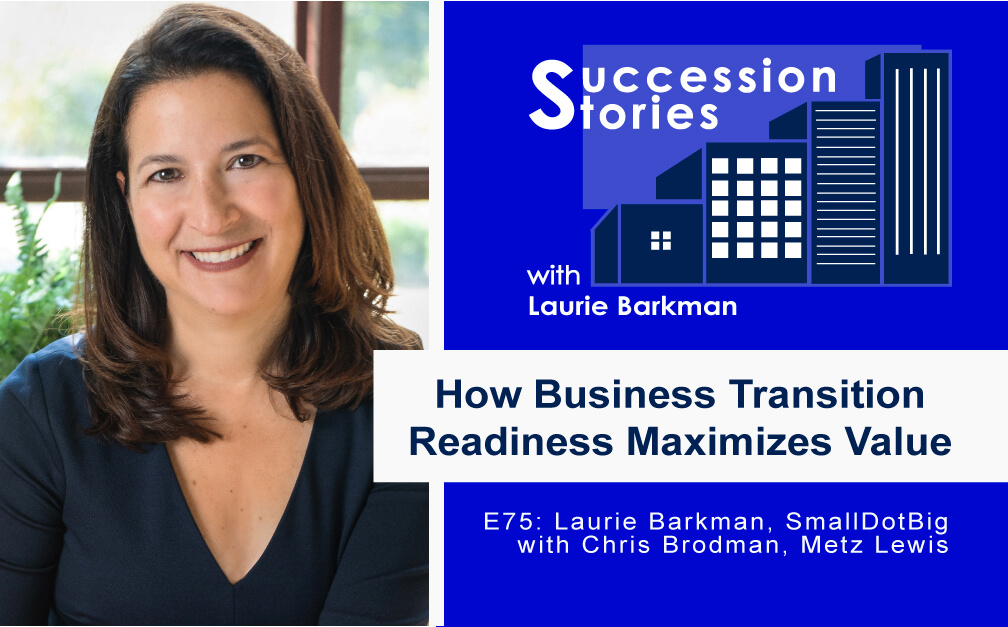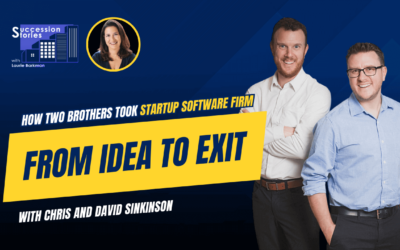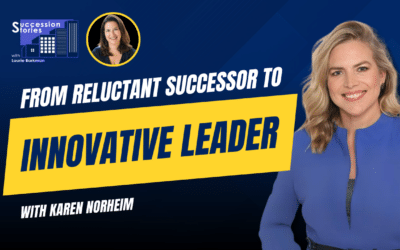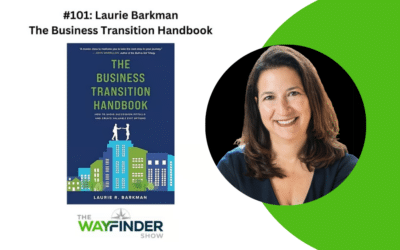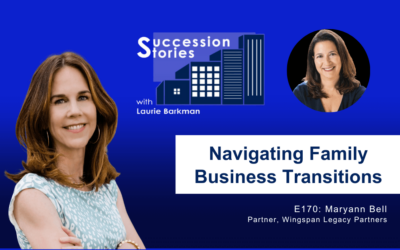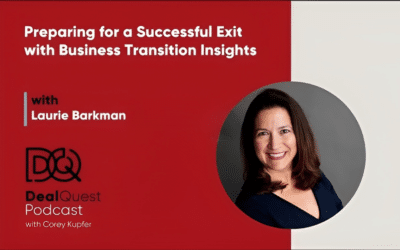Business Transition Readiness
We’re spotlighting business transition readiness. Why maximizing your business today can help you prepare for an exit on your terms tomorrow. This episode features an insightful presentation from Laurie Barkman (host of Succession Stories/Founder SmallDotBig) in a webinar with Chris Brodman, President of Metz Lewis Brodman Must O’Keefe, a Pittsburgh PA, law firm specializing in mergers and acquisitions and business transactions.
About:
The Succession Stories podcast is hosted by Laurie Barkman, Founder of SmallDotBig. We’ll help you maximize business value, plan your exit transition, and get rewarded for all of your hard work by finding the right buyer or seller.
If you’re not yet getting our monthly newsletter, now is a great time to sign up. Be among the first to hear about Laurie’s new book, upcoming events, and more great content to help you capture value and transition with success.
Show Links:
Connect with Laurie Barkman on LinkedIn
Transcript:
Laurie Barkman
Welcome to Succession Stories! I’m your host, Laurie Barkman, Founder of SmallDotBig. As an exit value planning and M&A advisor, I call myself a Business Transition Sherpa. My mission is guiding entrepreneurs on ways to build value in your business, and then benefit by letting it go. On this show, we spotlight the theme of transitions– not only to reward you for your hard work, but also to ensure that you look back on your succession without regret. Catch all the episodes and subscribe wherever you listen to podcasts, and be sure to visit successionstories.com to sign up for our newsletter. Here’s to your success!
Laurie Barkman
Happy new year! It’s the start of 2022 and I’m thrilled to be back. This year the Succession Stories team will bring you more business transition content and lessons learned from incredible entrepreneurs. You’ll want to follow Succession Stories in your favorite podcast player to get all the episodes. I’m super excited to share that I’m working on a book inspired by my work with entrepreneurs focusing on exit value planning and having a succession mindset. More to come on that! If you’re not yet getting my monthly newsletter, now is a great time to sign up on the show’s website SuccessionStories.com. You’ll be amongst the first to hear about my new book, upcoming events, and more great content to help you capture value and transition with success.
Speaking of events, that brings me to today’s episode. I’m sharing an excerpt from a webinar that I did with Chris Brodman, President of Metz Lewis Brodman Must O’Keefe, a law firm specializing in mergers and acquisitions and business transactions. Chris was an early guest on Succession Stories on episode 26, and is a good friend of the show. Our conversation is about transition readiness and maximizing value. Chris does a great job teeing up the topic of value creation and reducing risk, and then turns it over to me to discuss how maximizing your business today can help you prepare for an exit on your terms tomorrow.
Chris Brodman
Readiness is one element of a company being a great asset. It’s an element you can control to some degree as Laurie is going to talk about a little bit later. It’s something that really deserves your attention because if your company’s not ready, that equals risk, that equals a lower price, or no price. Because a lot of companies that want to sell, they haven’t prepared and they get there, there’s not a buyer.
There’s a company we just closed a deal with. It was a tough deal to get done because the sellers did not have a ready business. We closed the deal, and we got a great buy. We got a great buy because they didn’t do the things that they needed to do to take a bunch of risk out of their business. Laurie is going to talk about readiness a little bit later. But the one suggestion I would have on that to keep in mind is the bottom there. Be intentional and process oriented. It doesn’t happen by accident. You don’t just wake up and say, “Okay, in the next six months, I’m going to sell. I’m going to get ready.”
You need to be intentional about that, you need to grab on to the types of concepts we’re talking about here. You need to be a believer that these things matter. Then you need to be intentional about how you go about making your business ready. Part of that is running a process. I think that it is not a one man show. That is something that you likely need someone like Laurie to help you walk through because there are proven frameworks for how to go about this. If you don’t operate within a proven framework, it can really be overwhelming. You don’t know where to start. There’s so much to handle that it’s very helpful if you’re working with someone who knows how to run through that process. Take the noise out of it and keep your eye on a direct path to readiness. So, Laurie, hopefully I’ve teed you up well.
Laurie Barkman
Thank you so much, Chris and Metz Lewis, thanks so much for sponsoring this webinar this morning. I’m really glad to be here with you all. One of the things that Chris talked about was the amazing amount of activity happening in the market.
I’ll tee up some challenging statistics and in doing so I’ll also introduce a bit of my background. But as we talked about so many of the positive things happening in the market, I think it’s important to think about just some of the macro recognitions that 100% of business owners are going to exit their business at some point.
That’s kind of a profound thing if you think about it. You’re either going to leave boots on or boots off, as we like to say. But only 20% have a formalized plan. And so for me and who I am, what I do, and my background, I’d call myself an operator. I’m an operator that’s turned into a business transition sherpa. A sherpa, somebody who guides the process, and on the front end is growth. It’s increasing the value of your business, knowing what makes it ready. And then working with business owners to help them maximize and amplify that potential.
Only two out of every 10 businesses that come to market actually sell. That might be surprising, but then when you reflect on some of the comments that Chris made earlier, it’s because there are things that can hold back a company from the market that it is inherently too risky, in the eyes of a buyer, and inherently is not transferable.
In my experience, I’ve worked with small companies up to big, my firm called SmallDotBig, is a nod to that. But also it’s really about how we help companies not only achieve their growth objectives, but do it in a way that creates value.
That’s really my mission is to work with business owners anticipating a transition in the future. I like the word transition because it is about change. It is about different options and creating options.
And Chris will talk about some of those options as we go further in this presentation. But we can presume for today’s conversation that there are many business owners that might be interested in selling.
And that’s the other thing that I do is another hat, I am a partner with an M&A advisory firm specializing in the lower middle market called Stony Hill Advisors. I work on both the buy side and the sell side with business owners and small businesses to help them achieve their goals.
What’s really interesting about this last statistic, about 75% of owners experiencing regret within one year of exiting– when I talk to business owners who are interested in selling and one of the first things they say is I’m the SME or I’m the subject matter expert, that’s a red flag, because that person has the inherent knowledge, the inherent relationships. When they seek to leave, their identity is really tied into that business.
They don’t know what they’re going to do next. A lot of them will say I’d like to stay in the company in some way. I don’t mind being a consultant to the new owner. This path forward of areas that will help you be proud about your next and excited about your next make you see not only caring about the result financially, but also from a personal fulfillment as a way to look at success.
It’s about preparation for a transition. How do you prepare for an exit? That is a complicated question and a complicated answer, because there’s a lot of work to do. Chris alluded to some of that in his discussion. There are three core pillars of preparation. These can all take varying amounts of time and work and effort. The first is to maximize your business value. For me, most of my career was as an operator. I ran a privately held company subsidiary. We were acquired by a publicly traded company. The generations of work to maximize that business value and really get ready, that took years that was not an overnight thing. When I work with privately held companies that are in this lower middle market space, to recognize what it is that drives enterprise value. There’s trade-offs in that.
One of the things Chris mentioned earlier about making hiring decisions. Hiring a second in command, like a “2IC” as I like to call them, may cost you money. Maybe for a year or two, it will affect your profit, your profit margins. But longer term, it’s going to enable you to transfer knowledge and over time, transfer your company, in a sale or otherwise. Having a clear transition plan is part of that.
The second pillar is personal on the financial side, knowing what you need to live your life in a happy way after you leave your company. For some, and depending on what age bracket, the lifestyle you want to live. For some it might be, “I want to be in the grandparent business.”
I’m a podcast host, I have a podcast called Succession Stories. Chris was in an episode last year if you want to check that out. I talk to a lot of business owners, CEOs, people who have sold their companies, people who have bought companies. And in this transition phase, one woman who had built the company with her husband over 30 years, she said, I just want to be with my grandkids right now, I don’t want to buy another company, I don’t want to sit on boards, I don’t want to do anything. And that was her personal plan. She had her financial plan figured out.
The other side of this is understanding what lifestyle you want to live, what will make you happy. Then if you have a personal wealth advisor, to understand what those numbers mean, What number do you need to be able to live the life the way you’d like after you leave your company?
The life after business side of it, understanding your personal why. What strategies you need to put in place. There are four core pillars of things that I talk with clients about who are thinking about life after business.
One is having this future vision, why do you want to exit? What do you plan to do after you leave? The second is structuring flexibility in your life so that you understand how much is your business worth to you today. I also work with clients on that. One of the first things we do is we baseline your business right now. We baseline it on eight core drivers of value, many of which Chris has already mentioned.
The ability to transfer, understand the risks, understand what differentiates you. If we understand and compare you against your industry peers, and put a valuation on it. We have an understanding of the range of value, we might have a value gap between what you need in your future and where you are today. If there is a gap, and many times there is, that’s where we have to work on maximizing the business value. This is a continuity of preparing for exit.
So how can we create more value inherently, there is a balancing act that’s happening between creating enterprise value and growing and mitigating that risk. So there’s a difference between readiness and attractiveness. And I guess if there’s one thing that I want to sort of underscore today, in addition to the second point here, about transferability, it’s this one. Because you think your business is ready, and you think your business is attractive, doesn’t mean that in the eyes of a potential acquirer, they agree with you, or they see it the same way. Meeting in the middle, really understanding what risks might be holding you back.
What are detractors from your valuation, or where you might be able to punch above your weight class and attain a higher multiple than your peer group. How can you protect that value before you seek to build additional value? What might be some obstacles? Well, data from BEI, a 2019 survey of business owners, asked a question and the number one answer of what is standing in the way of your exit? They said, I need to improve the business first.
To someone like me who works with business owners on helping them get ready, and really understanding what creates enterprise value, where they are today. This was not a surprise to me. I think from what Chris said earlier, he sees it too. We need to get the financials ready. We need to have the readiness factors in place.
What are some of those factors that impact business value? Chris said, it’s about size. And certainly that is important. Size, industry, some of the characteristics of the business, the growth potential.
Why does growth potential matter?
Well, if it’s a business that has already maximized its full potential what does that leave for the new owner? What I like to say, what field is left to plow?
What can they be looking at as an opportunity, so that the competitive differentiation is also very important?
Is there something special about this business? Whether it’s intellectual property, whether it is software or technology. It might be the methodology of the business and how they go about it. It might be their customer list. There might be other aspects of competitive differentiation.
Recurring revenue is also very important because for the predictability of future cash flows, and assessing the risk in the business. A business that has a model like a subscription. We’re used to getting Netflix, for example, we just put it on our credit card and kind of set it and forget it. Or it might be contracts.
There’s a difference between recurring as spelled here on the slide, and reoccurring with an O. Because re-occurring is not contracted, it just might happen because of relationships that we have. But if those relationships are with the Rainmaker, the person steering the boat, in charge of sales for the company, if that’s the owner, if that’s you, and you’re going to be leaving, well, that presents risk. So again, it all ties back to having a large and loyal customer base.
By the way, do you measure it? Do you use Net Promoter Score or other things that can quantify what retention metrics you have? All the KPIs or key performance indicators around your customers can be very important to showcase potential value. Can we show that we are not so dependent on a single customer, that we have deep customer concentration?
Well, it might feel great from a revenue standpoint that, oh, we have these wonderful relationships. Again, it represents risk in the eye of the beholder of the buyer. It’s on the employee side, too. So Chris mentioned having employees from a contractual standpoint, how committed are they contractually? But also it could be how committed they are because of the loyalty they have, the culture that you’ve built in your business, or other aspects that may have them committed with financial incentives. And then lastly, is customer or excuse me, supplier concentration, those can also derail the value of your business.
Because some examples have to do with technology. If some companies that are so stitched into Apple as their platform, and Apple changes their terms of service, well, that can really take the value of the business because they then have to change course, redevelop, etc. But it could also happen on the supply chain, we’re seeing a lot of issues now with concentration on the supply side, that people have had to find other alternatives. So internal operating systems are also super important.
Why? Well, if you have a business that is transferable, that means people know how to do the work without you telling them how to do it. They’re not always bouncing back for you to answer their questions and solve their problems. You’re not the chief firefighter in charge. So documenting your processes, having those processes reviewed, periodically is a great place to start. It not only helps you bring on new people in an efficient way, but also gives you the ability to measure success and performance. And if you’re showcasing that performance to a buyer, then again, it gives them that sense that there’s reduced risk from the team and we call a structural capital standpoint.
And then lastly, for a clear transition plan, that’s a written plan. It’s not in your head. It’s not because you told your wife about it or your spouse. It’s written down. A transition plan can mean a variety of things. It either is an emergency– “in case of emergency break this glass.” It’s either that plan, which is really a contingency plan. Or it’s what we are talking about today, which is really more the business transition and exit plan that gets you forward thinking and prepared for the future.
Laurie Barkman
My last slide is why it is important to start early. It’s because it takes time. How much time does it take? That’s a giant asterix which means it depends. But here’s some benchmarks if you want to have some generalities for four phases.
The first phase is preparation. And so where you are, where your business is, and it’s life cycle obviously impacts this. But for a company that’s more than 10 years old, or the business owner perhaps is in their 50s. Looking at it from an age where they want to be when, what age they are when they retire. You might even start sooner than this. The companies that really are focused on exit and transition planning. Bottom line is you’re focused on the economics of your business. So it is good business to be creating enterprise value. The long short of it, there’s no harm in getting your business ready, because you’re preparing in a way that’s creating value for you.
You may say, “Oh, well, Laurie, I don’t want to sell my company, I want to pass it down to the next generation, I want my family to be running it. Well, that’s fantastic. And I love to hear that. And again, on my show, I talk to a lot of family business owners. And what is super important there is to have a business that’s worth transferring. And also, I’ve worked in very mature industries, and I’ve worked in cutting edge disruptive industries. And so the message to a mature business that is possibly going through disruption is experiencing that not only because of COVID, but where it is in its life cycle. The message there is it may be too late, you’ve got to really start if you haven’t already.
Preparation is super important. The decision phase of actions to take exploring different options. Chris is going to talk about that in a moment, whether it’s creating an ESOP, internal transfer to management, third party sale, what have you, this can take longer than one to two years. We were being somewhat conservative, and saying one to two. But the decision phase is super important. Then also the transaction. This range is as well, as you can imagine.
For me, it’s working with some business owners to get ready. You know, Chris mentioned earlier that not having the financial package ready, I have one potential buyer who’s interested in a small business. And the owners, it’s been about two months, they haven’t given us the P&L statements. They just haven’t gotten their exit planning together to be able to send us that. That’s just one small example.
You can imagine how long it can take if you’re not ready, and you don’t have things prepared. That can drag it out. So for companies to initiate that transaction, go through due diligence, go through all the steps for closing, again, it can take a range of time from perhaps six months to two years. And now I turn it back over to you, Chris.
Chris Brodman
Thank you very much. That was excellent. Really, really great.
Laurie Barkman
My objective is for you to have a lucrative and successful succession. If you want to understand the value of your company today, the potential net proceeds of a transaction, and your financial needs after you leave the business, that’s a great place to start. The sooner you understand these numbers, the more time you’ll have to close the gap, if there is one. Take the next step by requesting an initial meeting to begin planning for your business transition and strategic exit today. Request a call with me by visiting smalldotbig.com. I look forward to speaking with you.

